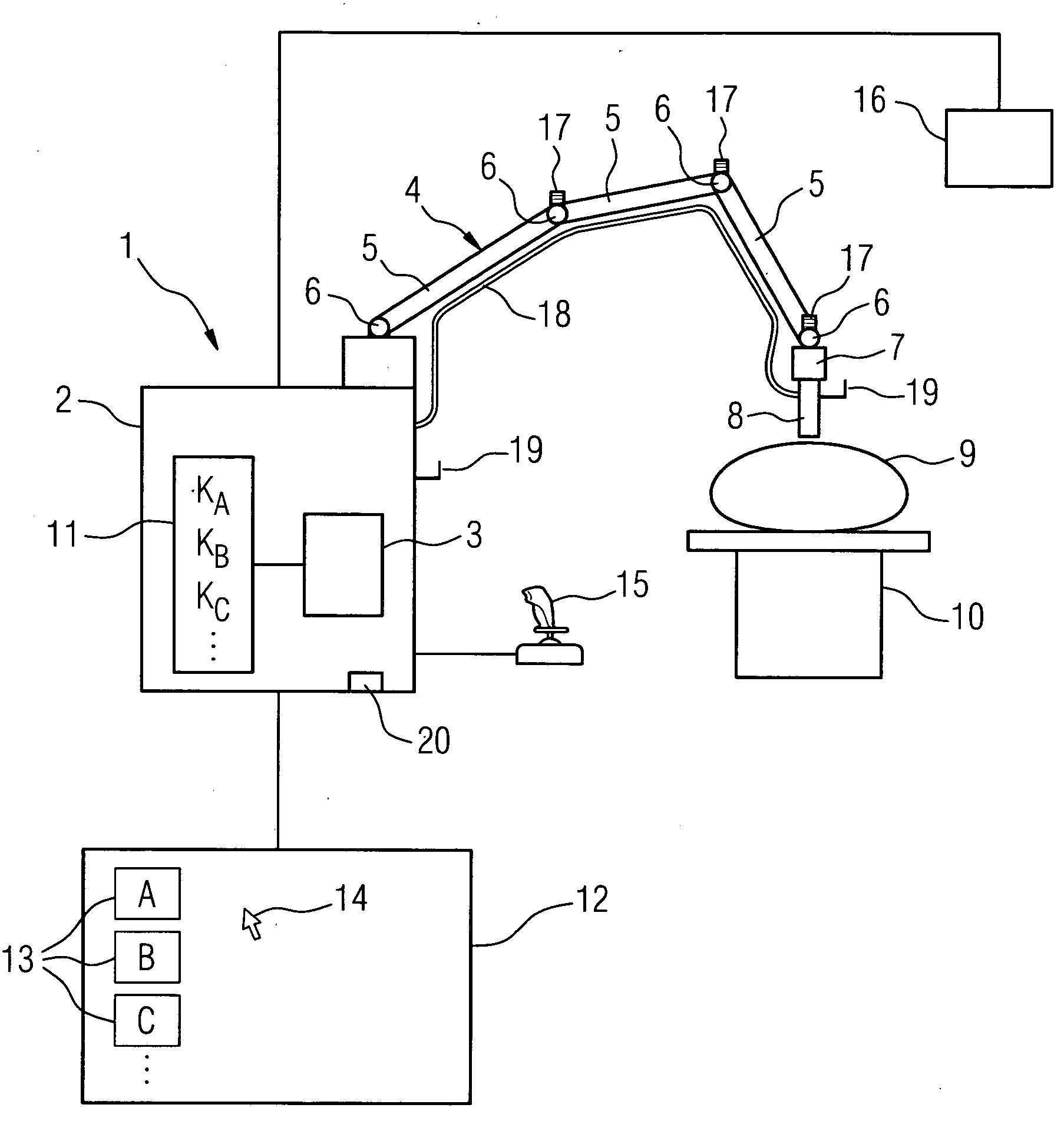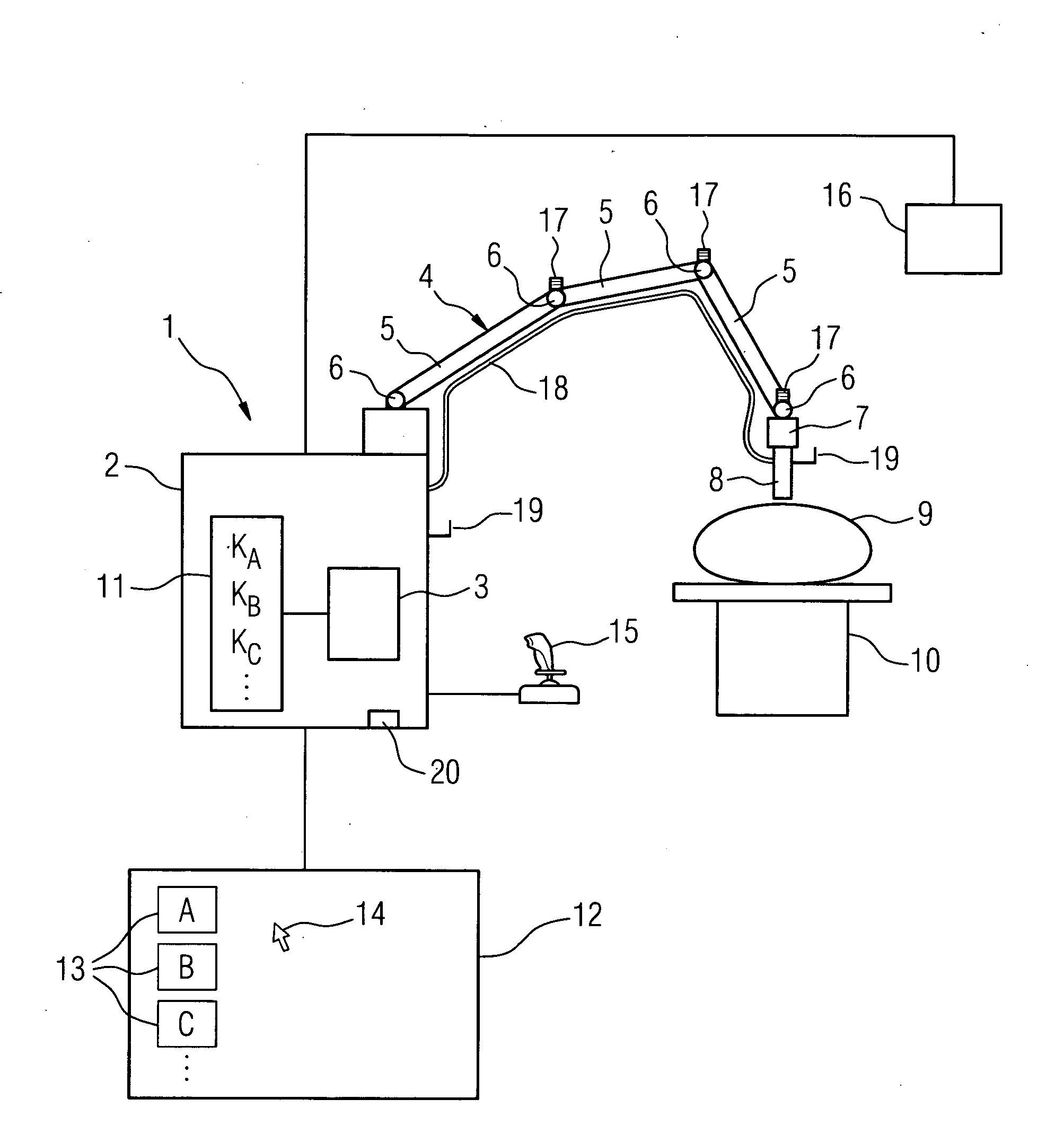[0007]Contrary to previous standard practice, with the ultrasound device according to the invention, the operator no longer moves the ultrasound transducer. The movement of the ultrasound transducer is carried out by a
robotic arm, which can be moved in space by at least
three degrees of freedom, preferably
six degrees of freedom. The more movable the
robotic arm, the better the directional positioning of the ultrasound transducer that can be achieved by the corresponding arm control. In one embodiment of the robotic arm, by way of example as multi-articulated arm, which can be moved by
six degrees of freedom, all longitudinal movements and also rotations around all spatial axes are possible, so that the ultrasound transducer can be moved to each position in the available movement capacity.
[0008]The use of a controlled robotic arm offers the possibility of automating the movement of the ultrasound transducer, so that the operator thus no longer has to move the head himself and search for the corresponding
image acquisition positions, incurring the risk of not going to specific relevant positions, and hence not recording any images from there. Rather using the
robot, it is possible for the movement operation of the ultrasound transducer to be controlled and automated, which can ensure that all relevant areas are actually captured and all the relevant
image acquisition positions are covered.
[0010]Thereby, in a particularly practical embodiment of the invention, at least one part of the
control curve, preferably all control curves, are assigned to specific examination areas or organs of the object to be examined. That means that area or organ-specific control curves, which define the optimal area or organ-specific movement paths, are stored for the image acquisition of specific examination areas or specific organs. This ensures that for each examination area or for each organ there is an optimal movement path and hence an optimal image acquisition at all-important positions and from all important transducer orientations.
[0011]To simplify the selection of the required
control curve for the operator, for practical purposes a selection device is provided, by means of which it is possible to select an examination area or an organ and hence the
control curve assigned for use in the examination of the said organ or area. A display screen is conceivable for instance, on which specific examination areas (e.g.
thyroid,
pancreas, liver, etc.) are indicated by different icons or in written form. The operator can then use the screen cursor to select the desired examination area or the desired organ, whereupon at the control device, the control curve assigned to the area or organ is automatically selected and subsequently followed in the course of the image acquisition.
[0014]In addition, for practical purposes, means are provided on the robotic arm to prevent the ultrasound transducer placing inadmissible pressure on the object to be examined, this prevents the transducer being pressed too hard on the object to be examined, causing the patient either to feel pain for a brief moment or to be injured. Such means can comprise at least one
force sensor and / or safety clutches in the region of arm joints. Through the means, regardless of what kind, an electronic control can carry out or if need be also stop the arm movement so that no inadmissibly
high pressure occurs or so that, if the pressure were to rise inadmissibly, the movement would be stopped immediately and possibly reversed. Thus if, for example, several force sensors are used on the arm, then said sensors provide corresponding signals regarding any increase in force. The electronic control can then alter the speed of movement etc. Here it is also possible to make a corresponding optimization of the respective control curve in relation to the respective object to be examined. For example, if the ultrasound transducer is travelling over the
abdominal wall, then the respective movement path in the case of a patient with a flat
abdomen is somewhat different from that in the case of a patient with rounded
abdomen. Using the corresponding means for preventing inadmissible
high pressure, an increase in force can now be detected, which indicates that the ultrasound transducer, for example because of the corresponding
abdomen rounding, must be raised a little so as to follow the shape of the abdomen without pressing too hard on the patient. That means that in this way it is possible for the ultrasound transducer movement to be adapted specifically to the object to be examined, by the control device continually detecting the force of the pressure or the application force and making corrective adjustments to the control curve, so as to control the physical circumstances according to the transducer movement.
 Login to View More
Login to View More  Login to View More
Login to View More 

